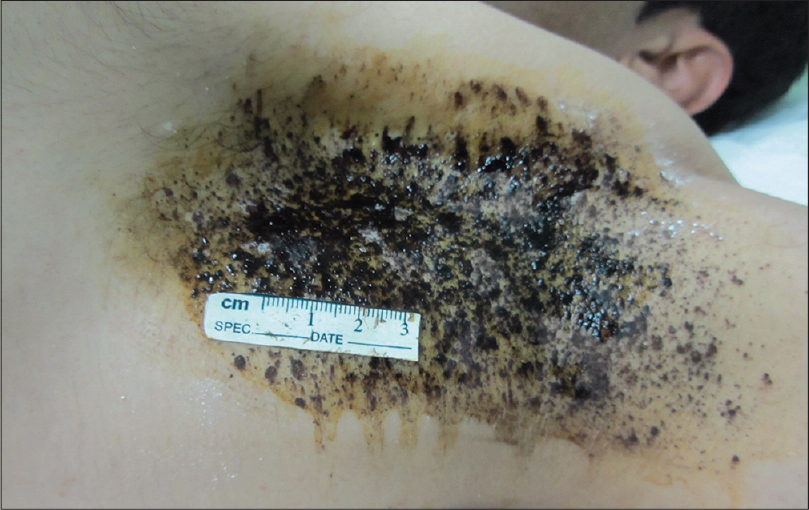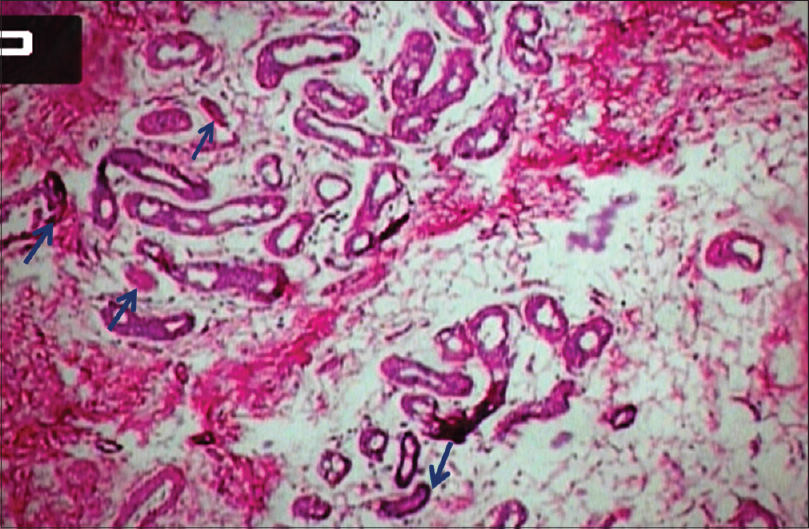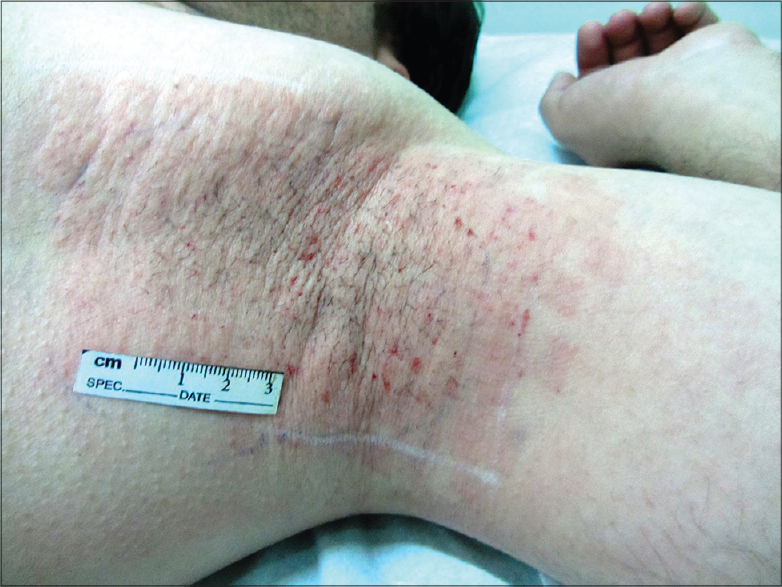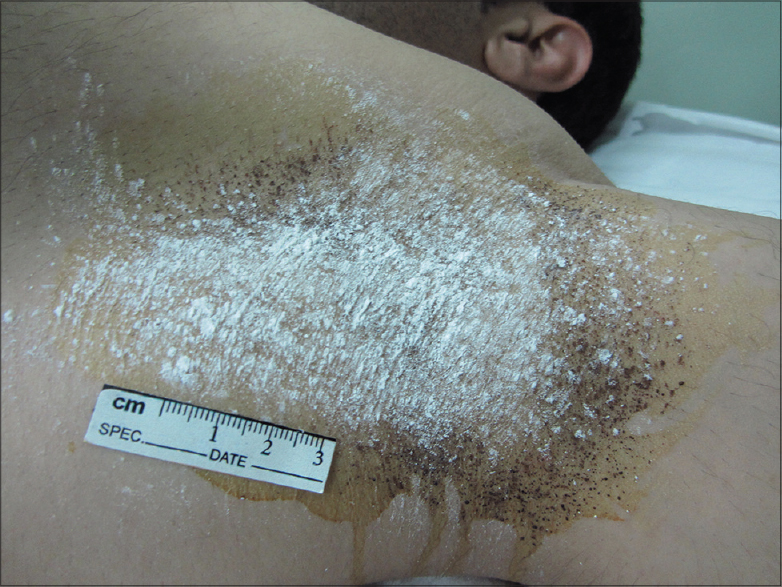Translate this page into:
Histopathological evidence of efficacy of microneedle radiofrequency for treatment of axillary hyperhidrosis
2 Department of Clinical and Pharmacy Practice Pharmacy Students' Research Committee, Department of Clinical Pharmacy and Pharmacy Practice, School of Pharmacy, Isfahan University of Medical sciences, Isfahan, Iran
3 Students' Research Committee, Department of Dermatology, Semnan University of Medical Sciences, Semnan, Iran
Correspondence Address:
Bahareh Abtahi-Naeini
Skin Diseases and Leishmaniasis Research Center, Isfahan University of Medical Sciences, Isfahan
Iran
| How to cite this article: Naeini FF, Saffaei A, Pourazizi M, Abtahi-Naeini B. Histopathological evidence of efficacy of microneedle radiofrequency for treatment of axillary hyperhidrosis. Indian J Dermatol Venereol Leprol 2015;81:288-290 |
Sir,
A major concern about the treatment of hyperhidrosis is the lack of clinical guidelines. Many medical (e.g. Botulinum toxin type A) and surgical methods have been used to overcome excessive sweating with variable results. [1] Energy-based devices have recently gained increasing acceptance for the treatment of many skin disorders and cosmetic conditions including facial rhytides and skin laxity. [2],[3] Recently, some researchers clinically evaluated the use of radiofrequency (RF) energy in the treatment of primary axillary hyperhidrosis (PAH), which suggest that the bipolar radiofrequency devices are effective in reducing the amount of sweating, [4],[5],[6] but very limited published data on histological confirmation of successful treatment is available.
We report the successful treatment of a 25 year old man with refractory primary axillary hyperhidrosis with fractionated microneedle radiofrequency (FMR). Topical treatment with aluminum chloride had been ineffective and the patient had discontinued it 6 months ago. He had received multiple sessions of botulinum toxin injections in the area, the last injection being 4 years ago. Systemic treatment with anticholinergic agents had to be stopped due to severe adverse effects.
The patient underwent four treatment sessions of fractionated microneedle radiofrequency FMR (INFINI; Lutronic, Goyang, Korea) at 2-week intervals. Pre-treatment results of the iodine-starch test are illustrated in [Figure - 1].
 |
| Figure 1: Starch– iodine test. Starch– iodine photographs of the left axilla of subject at baseline (blue-black sedimentation) |
The procedure was performed in four steps. Step 1: Sizing of the area to be treated and marking that area after starch-iodine test. Step 2: Topical anesthesia under occlusion. Step 3: Placement of hand piece on designated areas to deliver the therapy. Step 4: Dressing with sterile vaseline gauze.
The following settings were used: microneedle penetrating depth of 2.5- to 3-mm, level strength of 6 to 9, and RF time of 140- to 180-ms.
The biopsy sample taken 30 days post-treatment showed reduction in the number and size of both apocrine and eccrine glands after treatment [Figure - 2]. The density of sweat glands per low power field at base line and 30 days post-treatment was approximately 66 and 40, respectively. A mild lympho-histiocytic infiltrate, peri-glandular fibrosis, and neovascularization were identified surrounding the atrophic glands, suggestive of post-traumatic reactive changes. Coagulation changes of the glands (eosinophilic body) due to thermolysis is depicted in [Figure - 3].
 |
| Figure 2: Baseline biopsy of sweat glands (Right) and the posttreatment appearance of sweat glands (left) which show decrease in the number and size of both apocrine and eccrine glands after treatment. (Hematoxylin and eosin, ×40) |
 |
| Figure 3: Coagulation changes of the glands due to thermolysis (arrow) (Hematoxylin and eosin, ×100) |
The only adverse effects observed were erythema and pin point bleeding in the immediate post-procedure period [Figure - 4].
 |
| Figure 4: Erythema and pin point bleeding after FMR |
The results of the iodine-starch test at the end of treatment are shown in [Figure - 5]. During the 6-month follow-up, the patient had no recurrence.
 |
| Figure 5: Starch– iodine test. Normal results of starch– iodine test after four sessions of fractionated microneedle radiofrequency,(White sedimentation) |
Fractionated microneedle radiofrequency is a minimally invasive method that utilizes microwave energy to heat the target tissue without destroying the epidermis, by using rapid penetration with microneedle. [7],[8]
The radiofrequency energy from the tip of the microneedles causes direct thermal injury at the interface between deep dermis and subcutis, which results in thermolysis and decrease in the size and density of the apocrine glands, [9] while minimizing damage to surrounding tissue.
Johnson et al., studied the microwave thermolysis of sweat glands and demonstrated that microwave technology is well suited for targeting sweat glands while allowing for protection of both the upper skin layers and the structures beneath the subcutaneous fat. They demonstrated gross pathological and histological response with generation of thermally affected zones in the desired target region while providing protection to the upper skin layers. [10]
Kushikata et al., in serial skin biopsy samples taken post-treatment, showed progressively, necrosis of sweat glands, reduction of viable sweat gland structures, and peri-glandular fibrosis, suggestive of post-traumatic reactive changes. [11]
Our patients showed similar histologic findings of destruction of eccrine and apocrine glands and associated cell necrosis that localized at the junction of deep dermis and subcutaneous tissue. A clear decrease of viable sweat gland structures was seen compared to baseline sample with a sparse inflammatory infiltrate. [5],[10],[12]
Even though fractionated microneedle radiofrequency can be used as an effective, harmless, and nonaggressive method for treatment of primary axillary hyperhidrosis, further studies are needed to confirm and clearly define the histopathological changes induced in the skin by radiofrequency.
ACKNOWLEDGMENT
The authors would like to thank Dr. Zahra Bayat (dermatopathologist) for her help with providing histopathological pictures.
| 1. |
Komericki P, Ardjomand N. Hyperhidrosis of face and scalp: Repeated successful treatment with botulinum toxin type A. Indian J Dermatol Venereol Leprol 2012;78:201-2.
[Google Scholar]
|
| 2. |
Berube D, Renton B, Hantash BM. A predictive model of minimally invasive bipolar fractional radiofrequency skin treatment. Lasers Surg Med 2009;41:473-8.
[Google Scholar]
|
| 3. |
Hantash BM, Ubeid AA, Chang H, Kafi R, Renton B. Bipolar fractional radiofrequency treatment induces neoelastogenesis and neocollagenesis. Lasers Surg Med 2009;41:1-9.
[Google Scholar]
|
| 4. |
Hong HC, Lupin M, O′Shaughnessy KF. Clinical evaluation of a microwave device for treating axillary hyperhidrosis. Dermatol Surg 2012;38:728-35.
[Google Scholar]
|
| 5. |
Kim M, Shin JY, Lee J, Kim JY, Oh SH. Efficacy of fractional microneedle radiofrequency device in the treatment of primary axillary hyperhidrosis: A pilot study. Dermatology 2013;227:243-9.
[Google Scholar]
|
| 6. |
Fatemi Naeini F, Abtahi-Naeini B, Pourazizi M, Nilforoushzadeh MA, Mirmohammadkhani M. Fractionated microneedle radiofrequency for treatment of primary axillary hyperhidrosis: A sham control study. Australas J Dermatol 2014; [Epub ahead of print].
[Google Scholar]
|
| 7. |
Lolis MS, Goldberg DJ. Radiofrequency in cosmetic dermatology: A review. Dermatol Surg 2012;38:1765-76.
[Google Scholar]
|
| 8. |
Cho SI, Chung BY, Choi MG, Baek JH, Cho HJ, Park CW, et al. Evaluation of the clinical efficacy of fractional radiofrequency microneedle treatment in acne scars and large facial pores. Dermatol Surg 2012;38:1017-24.
[Google Scholar]
|
| 9. |
Grice K, Sattar H, Baker H. The effect of ambient humidity on transepidermal water loss. J Invest Dermatol 1972;58:343-6.
[Google Scholar]
|
| 10. |
Johnson JE, O′Shaughnessy KF, Kim S. Microwave thermolysis of sweat glands. Lasers Surg Med 2012;44:20-5.
[Google Scholar]
|
| 11. |
Nobuharu Kushikata M, Kim J. Histologic assessment of biopsy samples taken before and after the miradry procedure performed on a patient with axillary hyperhidrosis. Miramar Labs.Available at: http://www.miradry.biz/. [Last accessed on 2013 Dec 21].
[Google Scholar]
|
| 12. |
Lee SJ, Chang KY, Suh DH, Song KY, Ryu HJ. The efficacy of a microwave device for treating axillary hyperhidrosis and osmidrosis in Asians: A preliminary study. J Cosmet Laser Ther 2013;15:255-9.
[Google Scholar]
|
Fulltext Views
2,808
PDF downloads
522





